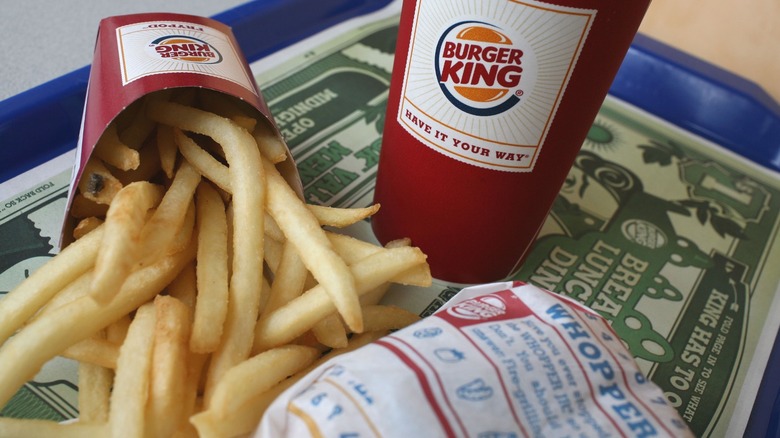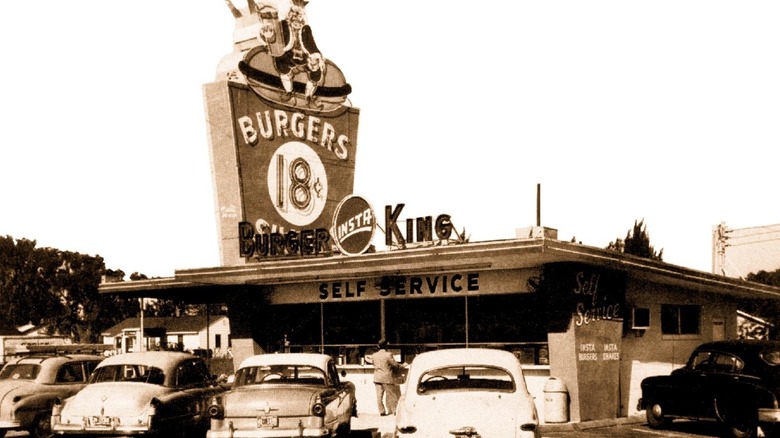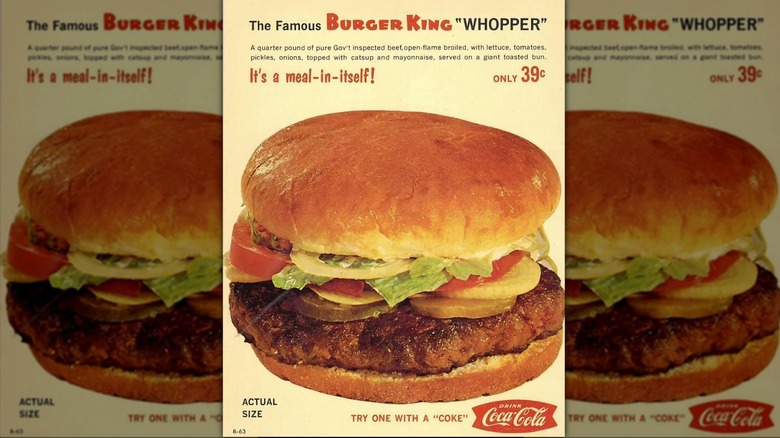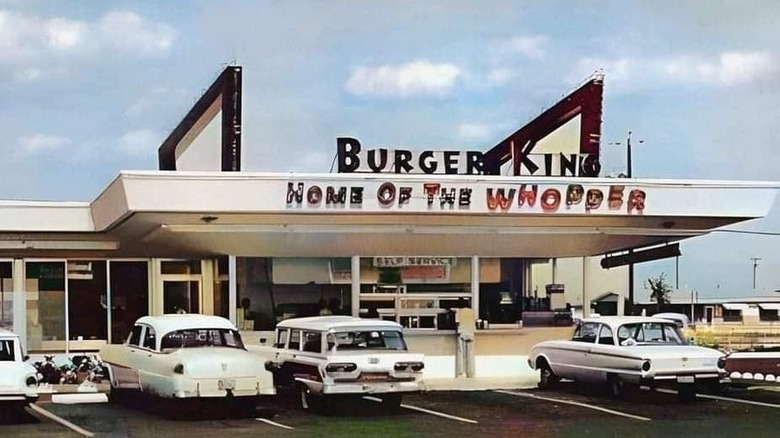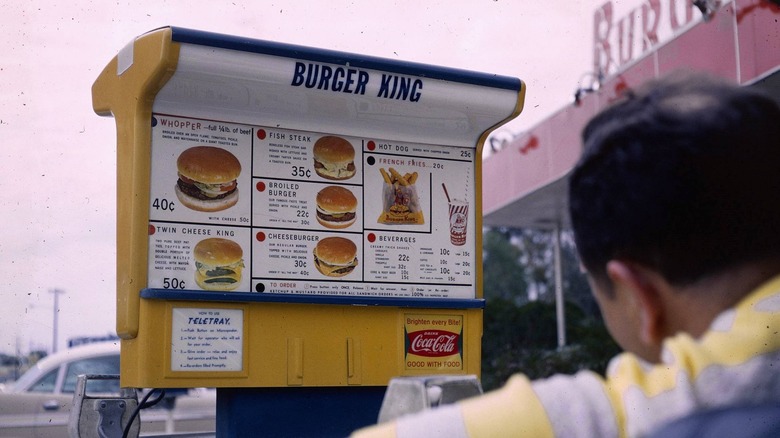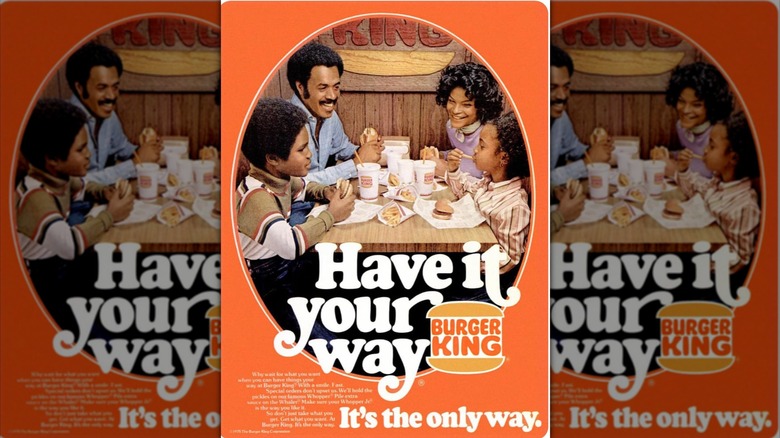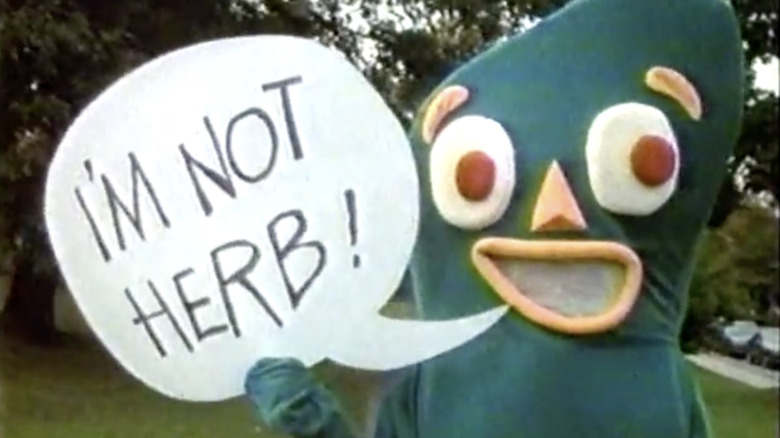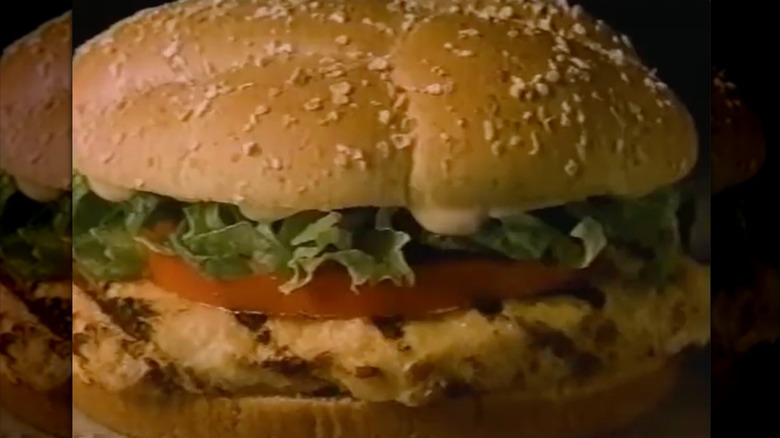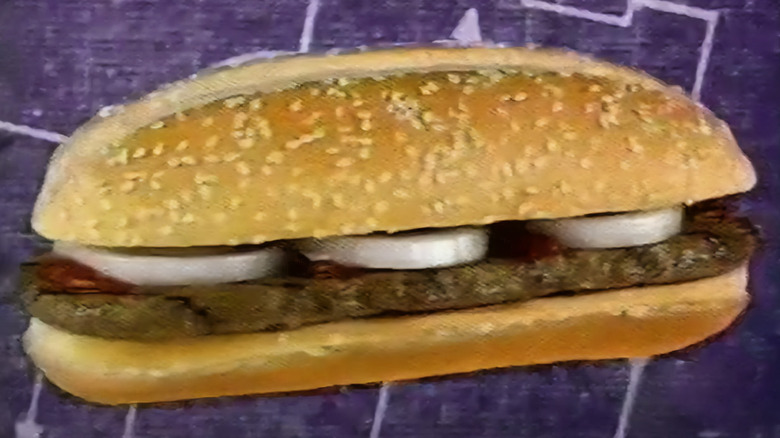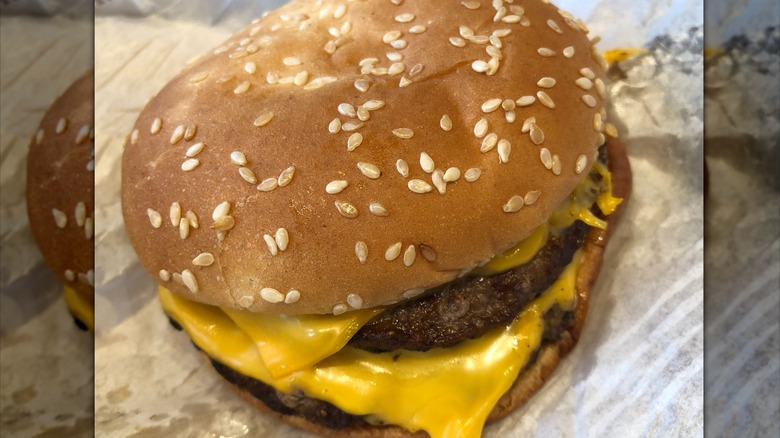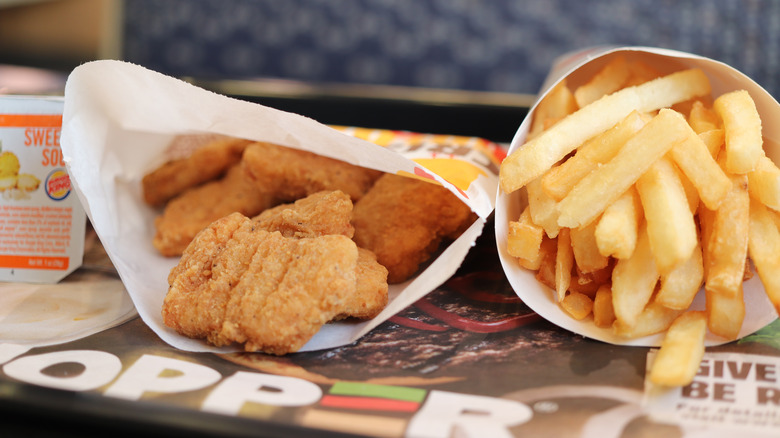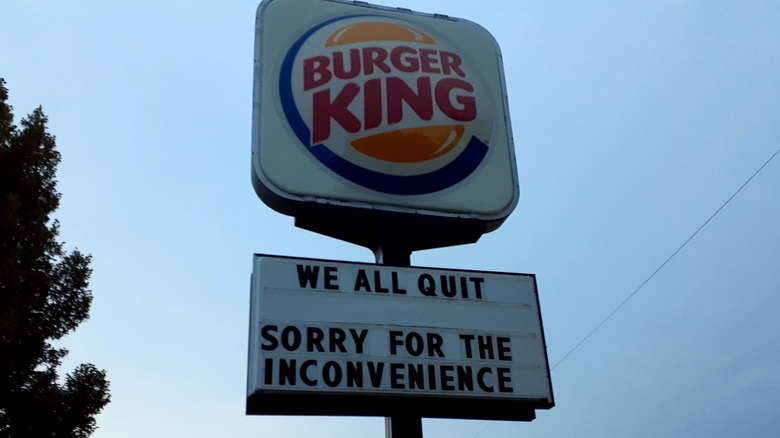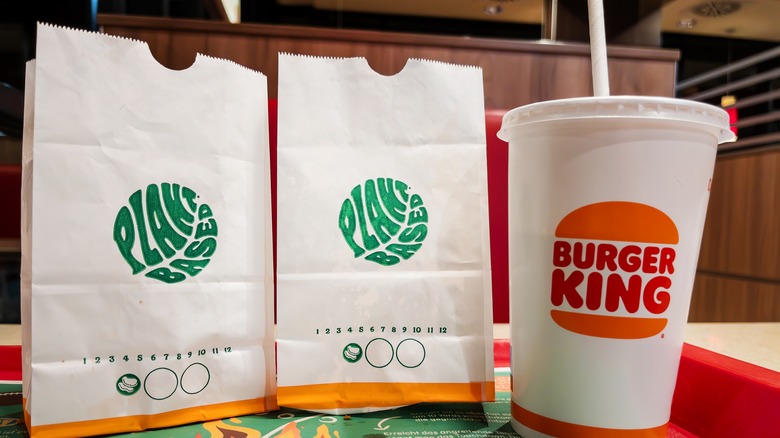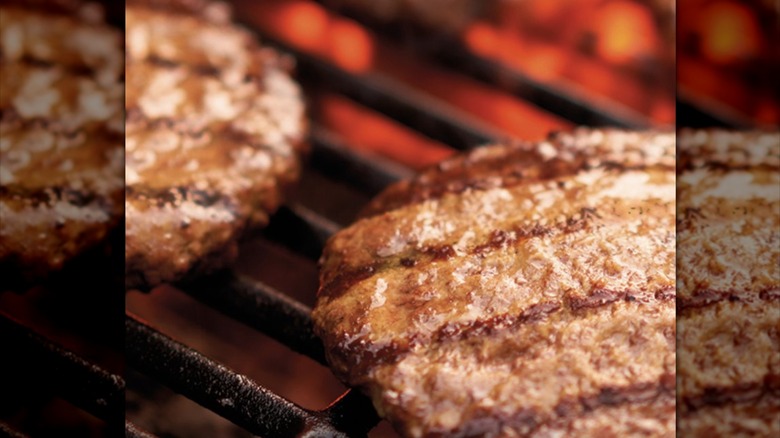The Rise, Fall, And Resurgence Of Burger King
It's hard to imagine Burger King stumbling out of favor. Sure, it has always played second fiddle to McDonald's, but regardless of how we feel about that, we've always counted on Burger King — the giant, the legend, the King — to be there. Things haven't become so dire for BK that it's in danger of going out of business (as of 2024, there are over 19,300 locations in 125 countries and territories worldwide), but there's no denying that sales have slipped and underperforming locations are closing. Sobering reality aside, Burger King hasn't made it this far to go down without a fight.
Burger King is a legacy fast food establishment of undeniable cultural prominence. It gave us the famous Whopper, which is a mic-drop situation in and of itself. It was also behind one of the catchiest TV jingles to ever grace the small screen. Oh, and it's been in business for 70 years. You don't get to be The King without a few chinks in the armor — and Burger King has had its share.
If you want to know more about Burger King's story, you've come to the right place. We're giving you the full BK bio: from its modest yet promising beginnings to behind-the-scenes financial drama, menu missteps, and more recently, a plan to regain its former glory. Is Burger King's resurgence here to stay? Let's find out.
Insta-Burger King walked so Burger King could run
Insta-Burger King opened in Jacksonville, Florida in 1953 as a no-frills, takeout spot serving burgers, shakes, and fries. Early on, founders Keith J. Kramer and Matthew Burns franchised a handful of Insta-Burger Kings throughout Florida, which was how David Edgerton came to own one in Miami, Florida in 1954. Edgerton's quick-service spot in Miami caught the attention of fellow businessman Jim McLamore, who owned a nearby restaurant. The two formed a partnership in hopes of growing Insta-Burger King's business. When the original owners ran into financial trouble, Edgerton and McLamore bought out the entire Insta-Burger King company.
Edgerton and Mclamore played upon their respective strengths in those early days. McLamore presided over the financial side, while Edgerton oversaw the cooking equipment, restaurant layout, and logo design. The original Insta-Burger King logo of a cartoon king holding a huge fountain drink and sitting atop a huge hamburger was drawn by Edgerton.
Before buying out Insta-Burger King's original owners, Edgerton and McLamore ran four locations. Rather than serving from a simple takeout window, newer Insta-Burger King restaurants boasted an enclosed dining room for guests. Edgerton and McLamore did all the prep work for the menu items in the back of the original store and delivered allotments of food to each location — something that Edgerton credits as part of their nascent success. The greatest part of Burger King's success, however, was just on the horizon.
A new burger boosted business
In 1957, David Edgerton and Jim McLamore launched a new burger that would be the crown jewel of BK's menu for decades to come. During a business trip in Jacksonville, Florida, McLamore and Edgerton stopped to check on one of their Burger King locations where business was struggling. Just down the street from the Jacksonville BK was a run-down roadside burger joint with lines out the door, and the Jacksonville BK did not.
The pair grabbed a couple of burgers from the competition and immediately understood what the fuss was about. The patty was significantly larger than the ones Burger King served. It came with mustard and chopped pickles — and it was delicious. McLamore knew that a burger like this was what BK needed to stand out. To market a sandwich that was bigger and contained more toppings than the average fast food burger, he proposed calling it the Whopper.
Edgerton understood that unleashing the Whopper's full potential meant cooking the meat to perfection. The Insta-Burger King flame broiler they currently used wasn't designed to grill bigger patties, so Edgerton built an improved model in a garage. The Whopper's 1957 debut was a monumental success. It also inspired a streamline in branding. The brand colors were narrowed to red and yellow while "Insta" was dropped from the company name. Burger King's updated restaurant signs declared the eatery as "Home of the Whopper."
The 1960s were all about expansion
The Whopper's entrance into Burger King's repertoire signaled the green light for mass domination. Franchising had been a part of Burger King's business strategy since the start, something that franchisees turned co-owners Edgerton and McLamore perhaps understood better than anyone. As the 1960s were underway, more and more BK franchises began popping up throughout the United States, officially making it a national chain. In 1963, Edgerton and McLamore set their sights even further and opened a Burger King in Carolina, Puerto Rico.
It was the first Burger King outside of the continental U.S., and marked a momentous occasion for Puerto Rican locals. Luis Arenas Pérez, a Cuban immigrant who had worked for Burger King in Miami, was the franchisee of Puerto Rico's flagship location. According to historical accounts, the expected supply of sesame seeded Whopper buns didn't arrive in time for Burger King's opening day in Carolina. Arenas Pérez decided to use plain hamburger buns as a substitute rather than opt out of serving the eatery's legendary sandwich. Arenas Pérez's quick-thinking move has been credited as a precursor to the Whopper Jr.
BK's success on the island fortified confidence that tackling the international market was possible. Arenas Pérez would oversee the Carolina location for the rest of his professional life. By the 1970s, Burger King locations were opened in Canada, Europe, and Australia.
Cracks in the franchising operation showed early on
The decision to franchise was Burger King's not-so-secret way of becoming huge. However, in the early days of fast food, some franchisees also wanted to be entrepreneurs. This was a business challenge Burger King faced in the late 1960s. Some franchisees who owned upwards of two dozen Burger King locations didn't feel they had to abide by policies put in place by Burger King execs, and took the liberty of using their own food suppliers and setting up independent training programs. As a result, Burger King had issues with keeping a consistent menu nationwide — not a good look for the emerging fast food empire.
Certain Burger King franchisees were expanding even faster than Burger King itself. Jim McLamore and David Edgerton (the guys in charge), didn't keep close enough tabs on these eager franchisees whose locations were hurting the brand's quest for cohesion. In 1967, heritage food brand Pillsbury purchased the whole Burger King operation for a hefty sum of $18 million. That meant it was ultimately up to Pillsbury to keep the franchisees in line.
These executive-level issues were a foreshadowing of the Burger King we see today. One of Burger King's ongoing problems has been a frequent change of ownership. That said, throughout the 1970s and beyond, Burger King managed to open up shop so thoroughly on the global market, that its logo and The Whopper are almost universally known.
Burger King produced its most memorable advertising in the 1970s
The tense mood in Burger King's executive offices wasn't getting the marketing department down. In the 1970s, Burger King hit a literal high note with an ad campaign in the form of a TV commercial jingle. The ad reached middle America in 1974.
In a brilliant song, Burger King's ad explains that if you don't like mayo, you don't have to eat it on a BK burger. Why? Because you're having it your way. The ad also highlighted what some say is peak BK uniform style. The trendy BK ladies behind the counter are wearing the company-issued uniforms in the ad. There are two versions of the "Have It Your Way" jingle: a show tune-inspired rendition and the soul version (the soul version wins every time).
The ad is still considered one of the best marketing campaigns of the 20th century. It was a good time for Burger King in overall sales and profitability, and helped the company reign as the second-best fast food burger franchise ever — only behind McDonald's.
Experimental changes in the '80s were a little wacky
By the 1980s, Burger King was the second largest restaurant chain on earth — a prospect that would grow even more throughout the decade. The '80s saw Burger King focusing its expansion sights on Asia. Something else Burger King fixated on back then was the competition. This hyper-aware approach produced more than a few oddities on BK's menu and in its far-flung advertising efforts.
Burger King felt the need to offer almost everything its competitors sold, resulting in some menu additions that were haphazard at best. To keep up with White Castle, BK sold a bundle of sliders that were served like a conjoined cluster of baked goods. It sold fish sticks simply because McDonald's had successfully launched the Filet-O-Fish. Menu mishaps aside, one of the weirdest things Burger King has ever done was its "Where's Herb?" ad campaign, beginning in 1985.
Someone in BK's agency decided to invent an imaginary guy named Herb who had never tasted Burger King before. When actor Herb finally appeared on camera and agreed to a limited press tour, BK a $5,000 prize was offered to anyone who spotted him lurking around a random BK (making a Herb-spotting controversy almost inevitable). The ads also assured people they could go to their local BK and utter the phrase "I'm not Herb" to unlock a 99 cent Whopper special. It's okay, we don't understand either. What we do know is that the campaign cost Burger King $40 million.
The BK Broiler was a catalyst for healthy fast food
After decades in the biz, Burger King longed to be known for something other than the Whopper. The fast food's popularity was alive and well at the dawn of the '90s, but Burger King did notice some dietary trend shifts that were in the making. The seeds of a health-conscious era were planted years earlier, but it wasn't until 1990 that Burger King attempted to cash in on a "healthy" food venture.
Cue the BK Broiler. The meat in this sandwich was a skinless chicken patty that was flame-broiled in Burger King's signature style. Selling a fast food chicken item without an armor of deep-fried crispy skin was all but unheard of at the time. The BK Broiler was served on an oat bran bun and came with lettuce, tomato, and ranch dressing. Thanks to Burger King's ability to take an accurate reading of the general population's wants and needs, the BK Broiler was a major high point in the chain's repertoire.
The appeal of BK Broiler had other fast food chains mimicking Burger King for a change. In a New York Times article from March 1991 about the rise of health-conscious fast food options, the BK Broiler was called "one of the most successful products ever introduced in the fast-food business." If only the success could last.
Burger King's struggles with consistency began to hurt sales
Burger King was great at putting up an impenetrable front, but signs of trouble were decades in the making. An unstable brand identity and frequent changes in ownership began to hurt sales in the 1990s. In an attempt to go upscale, the chain rolled out efforts like Burger King Baskets and a meatloaf sandwich — two menu items that were flops. The public wasn't buying into BK's foray into "formal" dining and they didn't expect table service from the cashiers either.
Pillsbury owned Burger King from 1967 to 1989 and spent too many of those years fighting off unruly franchisees. Most notorious among them were Billy and Jimmy Trotter, whose $100 million offer to takeover Burger King was refused by Pillsbury ... twice. Pillsbury and Burger King were acquired by British company Grand Metropolitan. Less than a decade later, a merger with Guinness transferred BK's ownership to Diageo plc., a powerhouse conglomerate that didn't seem to have Burger King's well-being at the top of its priority list.
Franchise chaos and a recession made the 2000s tough
Edgerton and McLamore's franchising strategy may have fast-tracked Burger King to the big time, but after decades of drama, the enterprise was becoming a problem child in the corporate arena. Burger King may have gotten lost in the shuffle of a 1997 bigwig merger, but this proved to be a temporary issue. In 2002, Diageo sold Burger King for $1.5 billion. These rapid changes made a business relationship between the owners and franchisees all but nonexistent.
Around 99.7% of Burger King's locations are franchises, and reports of discontent amongst private owners are literally old news. A 1988 report from The New York Times revealed that BK franchises were so disgruntled, they were considering a leveraged buyout to break loose from Pillsbury's indifferent leadership. It was a grim foreshadowing of franchisee woes that plagued Burger King during The Great Recession of the late 2000s.
During the recession, hostility brewed over franchisees' claims that corporate-set prices were endangering the profitability of Burger King locations throughout the U.S. There was particular contention over the $1 Double Cheeseburger. Franchisees insisted that this set price caused a financial loss every time a customer ordered one. In 2009, the $1 Double Cheeseburger was at the center of the National Franchisee Association's (NFA) lawsuit against Burger King. The lawsuit was dropped in 2011.
Burger King was slow to modernize
Once upon a time, the creativity on Burger King's menu was teetering off the rails. By the 2010s, the food and drink options just felt boring. While Burger King stuck to the same old soda, burger, fries, and chicken routine, its rivals got trendy, selling cappuccinos, smoothies, paninis, and wraps. Burger King, a former factory of ideas in the '80s and menu trendsetter in the '90s trailed the competition in more ways than one.
In 2010, sales profits were down 17% and its performance on the stock market was abysmal. Burger King tried to blame the fragile, post-recession, but the fact of the matter was, chains like McDonald's and Wendy's thrived by updating its menus with items that people actually wanted. BK took the hint, but its plan of action was indirect at best. It opened its first-ever location in Russia and embarked on a restaurant remodeling project. Approximately 12,000 stores were refitted with a cooler, industrial-esque look. BK's menu would now be displayed on high-tech electronic screens — the menu itself stayed the same.
The COVID-19 era was a mess
When the COVID-19 pandemic hit, the sobering reality of slowing sales affected every single player in the global food service industry. In Burger King's case, it also exposed the company's poor response to keeping its workers safe in a time of crisis. In summer 2020, Burger King's name was on the wrong side of COVID-19's media coverage when workers nationwide staged a mass protest against the chain's lax response to personal protective equipment (PPE) in the workplace.
One Burger King employee in Santa Monica, California died after management brushed off her ongoing coronavirus symptoms as side effects from hormone injections — the employee was a transgender woman. The tragic event created a ripple effect in which BK employees publicly rallied against poor working conditions. Many restaurants had learned how to cope by 2021, but the situation at Burger King had not improved.
"We all quit sorry for the inconvenience," read the marquee outside a Burger King in Lincoln, Nebraska. The gesture made headlines in July 2021 after upwards of 11 workers walked out due to short staffing and oppressive work conditions. Rachael Flores, the general manager of the location responsible for the sign, told The Washington Post, "We became essential, and then we weren't treated essential by upper management."
To rebrand, Burger King looked to the past (and the future)
A beleaguered Burger King saw the writing on the wall in 2021, and vowed to change the message with a total rebrand. Improving its image involved Burger King tapping into the halcyon days of its legacy, and channeling that look and feeling into the future. Design agency Jones Knowles Ritchie was hired to reimagine Burger King's logo, uniforms, and general message to the world.
The result was a neo-retro overhaul. BK's existing logo was traded in for a fresh interpretation of the minimalist logo from the 1970s. New uniforms, accented with vintage shades of chocolate brown and mustard yellow struck a balance between old and new, as did the groovy, round-edged typeface widely adopted on said uniforms and in BK's latest packaging.
The final piece? Coming to terms with one of fast food's stodgiest menus. On the success of the first plant-based Burger Kings in Cologne, Germany in 2021, the concept has opened up more than 15 locations around the world. The Impossible Whopper, a plant-based version of BK's greatest hit, is now a regular menu item on the international stage.
Can Burger King Reclaim the Flame in 2024?
Backed by the modernity of its 2021 rebrand, Burger King made another bold statement in 2022. The "Reclaim the Flame" plan pledges a complete reinvention of the BK brand as we know it. The company has invested over $1 billion in the endeavor.
To get the Reclaim the Flame movement rolling, Burger King acquired Carrols Restaurant Group, which operates over 1,000 Burger King and Popeyes locations. By bringing Carrols into the fold, Burger King can streamline its modernization efforts, an undertaking that seeks to give 85% to 90% of U.S. Burger Kings a long overdue facelift.
So far, the sales numbers have been on BK's side. Burger King's franchisees — once a perpetual voice of discontent in the company's trajectory, are on board with the movement. In 2023, Burger King's average profitability numbers were at a record high. Increased inflation rates in 2024 presented a challenge to the new objective, but after everything Burger King has been through, one should never count the chain out too soon.
